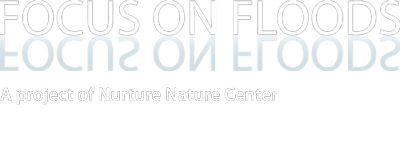The National Weather Service offers many forecast and warning tools that individuals can use during a predicted flood event. From tools that allow users to monitor projected river heights to flood inundation maps that show which areas in the community will be underwater during floods, the capability and accuracy of flood forecasting has increased dramatically in recent years. Despite these advances, many people still fail to understand and respond to flood forecasts and warnings issued by NWS. Beyond technological advances in forecast lead-time and accuracy already achieved, what else can NWS do to improve its flood forecast and warning tools so they better motivate flood preparedness and warning response?
Nurture Nature Center, through several social science research studies, has been working to understand how public and professional audiences understand and respond to various flood forecast approaches, and how to improve forecasting tools so that they better communicate flood risk and motivate people to take action. Through these projects, NNC and its research partner, East Carolina University, have engaged with residents, emergency managers, and water resource managers in Pennsylvania, New Jersey, West Virginia, Maryland, Colorado, California and New York to get direct user response to various flood forecast tools. Through focus groups and surveys in these riverine and coastal communities, the research team has been able to provide meaningful feedback to NWS and the weather enterprise at large about how to improve the presentation and delivery of information for these audiences.
The research team’s most recent study, “Making Sense of Uncertainty: Improving the Use of Hydrologic Probabilistic Information in Decision-Making,” was funded by National Weather Service through its Joint Technology Transfer Initiative program, to study the use of a new national system, Hydrologic Ensemble Forecast System (HEFS), to see how it can be improved to meet the needs of a wide range of users. The study made recommendations for a national HEFS prototype as well as regional variations that can be adapted to meet the needs of local communities, and also made a series of recommendations for communicating probabilistic information for decision-support services. The full study is available at https://focusonfloods.org/wp-content/uploads/2020/12/Making-Sense-of-Uncertainty-2020-1.pdf .
Prior to that study, the team completed a Major Risks, Uncertain Outcomes: Making Ensemble Forecasts Work for Multiple Audiences,” was funded by NWS to East Carolina University in 2016. The study looked in particular at the use of ensemble forecast products from NWS’ Hydrologic Ensemble Forecasting System (HEFS), and made recommendations for how these probabilistic forecasts could be improved, in display and delivery, to be more useful to a range of public and professional users. The full study is available at http://nurturenaturecenter.org/wp-content/uploads/2018/03/Major-Risks-Uncertain-Outcomes-_.pdf.
This study builds upon a 2012 study completed by NNC and ECU, focused on NWS riverine flood forecast and warning products. That study, “Flood Risk and Uncertainty: Assessing the NWS Flood Forecast and Warning Tools”, was funded by the National Oceanic and Atmospheric Administration through the Office of Ocean and Atmospheric Research as one of four social science awards designed to support NOAA’s Weather Ready Nation Initiative. That study looked at the suite of riverine flood forecast products, including the ensemble system MMEFS.
In 2014, New Jersey Sea Grant Consortium’s Coastal Storm Awareness Program awarded NNC a grant to study NWS coastal flood forecast and warning products. That project made recommendations about various coastal flood forecast products, focusing particularly on the use of emergency briefings.
“Given the frequency and intensity of flooding not only in this region, but across the country, improving how people prepare for flooding is critical to reducing losses,” said NNC Director Rachel Hogan Carr. “These projects provide an excellent opportunity to help NWS understand how the public uses its flood forecast and warning tools, and what further refinements might improve public preparedness as people respond to news of impending river or coastal flood events.”
